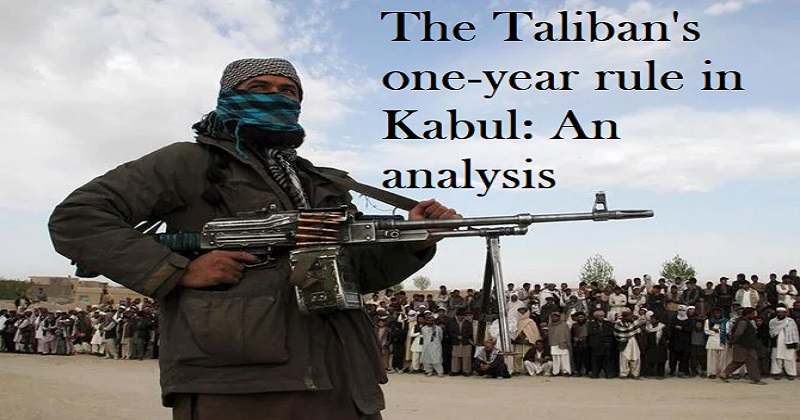
Exactly one year ago in August 2021, the Taliban swept entire Afghanistan and ousted the US-backed government of Ashraf Ghani. They initially faced some turbulences in Panjshir Valley but most of the opposition is either wiped out of Afghanistan or neutralized. The group which was formed in the aftermath when soviet backed Afghanistan government fell in 1992 has grown manifolds in the past three decades.
Taliban suffered the worst during America’s war against terror which went on for nearly two decades starting in 2001. They learned that the only way to get legitimacy is through diplomacy and hence they trained their leaders in negotiation. That’s how the ‘Doha Diplomacy’ started resulting in their present takeover of Afghanistan.
Let us examine the Taliban 2.0’s one-year rule in Afghanistan.
1. Warlord ouster – The Taliban were quick to recognize that the primary source of turpitude in Afghanistan’s previous governments was the warlords. For thousands of years, they were the ones who posed major challenges to any king/government, so the first thing they did was expel the warlords from Afghan territory. Today, nearly all of the warlords have sought asylum in neighboring countries, and their core fighters have either joined the Taliban/ISKP or vanished. This has paved the way for the Taliban’s rule to be largely uninterrupted.
2. Diplomatic relations with other countries –Taliban knew that if it has to rule over Afghanistan for a long time, it needs to have legitimacy and good relations with other countries are a must. Now Taliban is sending its leaders and spokespersons like Amir Khan Muttaqi to various countries who have been successful to some extent. Despite lacking proper recognition, Taliban 2.0 has been able to achieve a big milestone as compared to the previous Taliban 1.0.
3. Humanitarian and financial crisis – Afghanistan is facing a severe food crisis and there are inputs of large-scale deaths due to famine which remain unreported due to media censorship. As per the world food program, only 2 percent of the Afghan population has enough food to survive and 50 percent of its children below 8 years are malnourished. Taliban has been asking for money kept in foreign countries by its erstwhile government but there is no assurance that this money will not be used in terror activities.
4. Label of being a terrorist organisation- Taliban 1.0 was particularly known as a terrorist organisation and was active in support of Al Qaeda. In the last one year, they avoided speaking on the Al Qaeda issue. However, their cover was blown recently when Al Qaeda chief Ayman- al-Zawahiri was killed in a US drone strike in the heart of Kabul. It shows that although the Taliban is reluctant to divulge its proximity with terrorist groups, actually it is harboring them.
5. Women’s rights, education, and status –Most educated women have left Afghanistan while others are restricted to their houses. In today’s Afghanistan, women or girls do not have any right to study, take employment or gather peacefully in a place. The Taliban abolished the ministry of women’s affairs. Even their ethnic Pashtunwali code restricts beating or ill-treating women but the Taliban has even defied it when it comes to giving rights to women.
6. Unlawful killings & disappearances- Ever since Taliban 2.0 has taken over, there is no control on killings and forced disappearances of people, especially those who were related to erstwhile Afghan Armed forces or its intelligence. People from other tribes like Hazara, Shia, Tajik and Uzbek are also targeted and they are killed at the smallest suspicion. Most of the houses of people from Panjshir valley in Kabul are looted, destroyed and the residents are either killed or imprisoned.
7. Pashtun dominance and anarchy – Most of the Taliban cadres are Pashtuns and originated from Islamic Seminaries called Madrasas. Their affiliation with the so-called ‘Islamic Emirate of Afghanistan’ is not strong and they are just a mercenary. Now when they are put in power, it is difficult for them to be disciplined like the Army of a country and thus there is widespread anarchy in the country.
8. Proxy of Pakistan – Taliban is trying to fool the world by creating turbulences on Durand Line and singing the song of Pashtun unity but the reality is far different. Frequent visits of Pakistani ISI officials to Kabul & proximity of its top leaders with Pakistani leadership reveal all. If at all Taliban has to shed this tag, it has to curtail the position of the Haqqani network significantly.
9. Freedom of media- In the last year in Afghanistan, nearly 70 percent of the media outlets have been closed permanently and the balance is operating under grave threat. Journalists are killed, detained, or arrested which is considered common in Afghanistan now. It includes a recent incident on 4th August 2022 when Anas Mallick was arrested along with his crew and driver and was kept in custody for over 21 hours.
10. Resurgence of other terrorist groups like Islamic State- The anarchy in Afghanistan is giving rise to the fact that rival terror groups have risen significantly. The most important of them is Islamic State in Khorasan Province (ISKP). Due to the oppression and atrocities of the Taliban, more and more people are joining ISKP. Soldiers of the former Afghan Army, tribal fighters & other armed groups are left with no option.
One year of Taliban rule in Afghanistan did not progress well except a little on diplomatic fronts. Globally the Taliban leaders have failed to convince the world that they are not a proxy of terrorist groups as well as terror-supporting countries like Pakistan. It is this legitimacy for which Taliban 2.0 has been struggling for the past year and it is going away with each passing day.

Post Your Comments